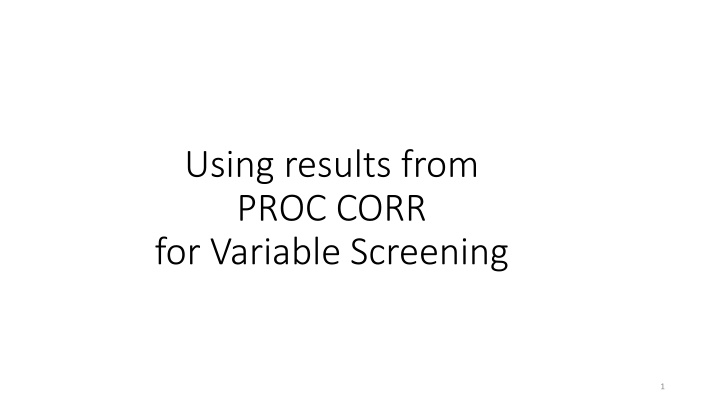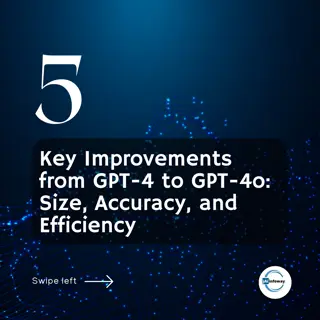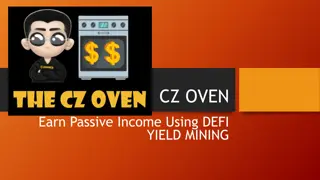Comprehensive Web3 Solutions for Your Business
We specialize in Web3 development, consulting, and security services, offering turnkey solutions for all your Web3 needs. Our services include smart contract security, blockchain development, DeFi, NFTs, custom solutions such as token presales and DAOs, support & maintenance, and more. With our expert team, tailored solutions, security focus, and innovative approach, we provide scalable solutions to empower your business in the Web3 era.
Download Presentation

Please find below an Image/Link to download the presentation.
The content on the website is provided AS IS for your information and personal use only. It may not be sold, licensed, or shared on other websites without obtaining consent from the author.If you encounter any issues during the download, it is possible that the publisher has removed the file from their server.
You are allowed to download the files provided on this website for personal or commercial use, subject to the condition that they are used lawfully. All files are the property of their respective owners.
The content on the website is provided AS IS for your information and personal use only. It may not be sold, licensed, or shared on other websites without obtaining consent from the author.
E N D
Presentation Transcript
Using results from PROC CORR for Variable Screening 1
The Spearman correlation statistic is the correlation of the ranks of the input variables with the binary target. Hoeffding s D detects a wide variety of associations between two variables. 3
Compare the results of the Spearman and Hoeffding paying attention to: Neither measure shows a relationship drop the variable. Decision based on p-value. Hoeffding results in higher measure than Spearman perhaps need some feature engineering Use ranking of measures for decisions. 4
The set for consideration. %let reduced= MIPhone MICCBal Dep MM ILS MTGBal Income POS CD IRA brclus1 Sav NSF Age SavBal LOCBal NSFAmt Inv MIHMVal CRScore MIAcctAg InvBal DirDep CCPurc SDB CashBk AcctAge InArea ATMAmt DDABal DDA brclus2 CC HMOwn DepAmt Phone ATM LORes brclus4; 6
The rank option in PROC CORR %let reduced= MIPhone MICCBal Dep MM ILS MTGBal Income POS CD IRA brclus1 Sav NSF Age SavBal LOCBal NSFAmt Inv MIHMVal CRScore MIAcctAg InvBal DirDep CCPurc SDB CashBk AcctAge InArea ATMAmt DDABal DDA brclus2 CC HMOwn DepAmt Phone ATM LORes brclus4; ods output spearmancorr=spearman hoeffdingcorr=hoeffding; proc proc corr var &reduced; with ins; run run; corr data=d.develop_a spearman hoeffding rank; 7
proc proc contents contents data=spearman;run proc proc print print data=hoeffding;run run; run; The variable names in the SAS data sets Spearman and Hoeffding are in the variables best1 through best39 The correlation statistics are in the variables r1 through r39 The p-values are in the variables p1 through p39. 8
We need to restructure the data sets so the identifier is the variable name and there is a single observation for each variable name. We also will want to keep the correlation means, its rank, and p-value for each observation (named to be different on the two data sets. 9
Restructure Spearman data %let nvar=39;/*reduced set*/ data data spearman1(keep=variable scorr spvalue ranksp); length variable $ 8 8; set spearman; array best(*) best1--best&nvar; array r(*) r1--r&nvar; array p(*) p1--p&nvar; do i=1 1 to dim(best); variable=best(i); scorr=r(i); spvalue=p(i); ranksp=i; output; end; run run; 10
Restructure Hoeffding data. data data hoeffding1(keep=variable hcorr hpvalue rankho); length variable $ 8 8; set hoeffding; array best(*) best1--best&nvar; array r(*) r1--r&nvar; array p(*) p1--p&nvar; do i=1 1 to dim(best); variable=best(i); hcorr=r(i); hpvalue=p(i); rankho=i; output; end; run run; 11
Merge the two data sets by variable name. proc proc sort by variable; run run; sort data=spearman1; proc proc sort by variable; run run; sort data=hoeffding1; data data correlations; merge spearman1 hoeffding1; by variable; run run; 12
Print results proc proc sort by ranksp; run run; sort data=correlations; proc proc print print data=correlations label split='*'; var variable ranksp rankho scorr spvalue hcorr hpvalue; label ranksp = 'Spearman rank*of variables' scorr = 'Spearman Correlation' spvalue = 'Spearman p-value' rankho = 'Hoeffding rank*of variables' hcorr = 'Hoeffding Correlation' hpvalue = 'Hoeffding p-value'; title "Rank of Spearman Correlations and Hoeffding Correlations"; run run; Title; 13
A low rank means a low p-value If the Spearman rank is high but the Hoeffding s D rank is low, then there may be an association that is probably not monotonic. (Empirical logit plots can be used to investigate this type of relationship.) A graph might help. 14
Get some values to draw reference lines proc proc sql select min(ranksp) into :vref from (select ranksp from correlations having spvalue > .5 select min(rankho) into :href from (select rankho from correlations having hpvalue > .5 quit quit; sql noprint; .5); .5); 15
Plot rank of Spearman vs rank of Hoeffding proc proc sgplot sgplot data=correlations; refline &vref / axis=y; refline &href / axis=x; scatter y=ranksp x=rankho / datalabel=variable; yaxis label="Rank of Spearman"; xaxis label="Rank of Hoeffding"; title "Scatter Plot of the Ranks of Spearman vs. Hoeffding"; run run; title ; 16
In general, the upper right corner of the plot contains the names of variables that could reasonably be excluded from further analysis, due to their poor rank on both metrics. The criterion to use in eliminating variables is a subjective decision. Four variables are eliminated from the analysis: hmown, mtgbal, Miccbal, locbal High ranks for Spearman and low ranks for Hoeffding s D are found for the variables DDABal, DepAmt, and ATMAmt. Even though these variables do not have a monotonic relationship with Ins, some other type of relationship is detected by Hoeffding s D statistic. Empirical logit plots should be used to examine these relationships. 17
The variables remaining %let screened= MIPhone Dep MM ILS Income POS CD IRA brclus1 Sav NSF Age SavBal NSFAmt Inv MIHMVal CRScore MIAcctAg InvBal DirDep CCPurc SDB CashBk AcctAge InArea ATMAmt DDABal DDA brclus2 CC DepAmt Phone ATM LORes brclus4; 18
Empirical Logits + 1 m log i + 1 M m i i where mi= number of events Mi = number of observations 20
A new macro PlotLogitsSeries %macro %macro PlotLogitsSeries(indata=,numgrp=7 7,indepvar=,depvar=); proc rank data=&indata groups=&numgrp out=Ranks; var &indepvar; ranks Bin; run; proc sql; create table toplot as select avg(&indepvar) as mean label="Mean of group", sum(&depvar) as num_chd label="Number of Events", count(*) as binsize label="Number at Risk", log((calculated num_chd+1 1)/ (calculated binsize-calculated num_chd+1 1)) as logit from ranks group by bin; quit; proc sgplot data=toplot; series x=mean y=logit/markers; reg x=mean y=logit; title "Estimated Logit Plot &indepvar, &numgrp groups"; run; title; %mend %mend PlotLogitsSeries; 21
%PlotLogitsSeries PlotLogitsSeries(indata=d.develop_a,numgrp=100 100,indepvar=ddabal,depvar=ins); There is a spike in the logits at the $0 balance level. Aside from that spike, the trend is monotonic but certainly not linear. 22
Examining means a little more closely -- the spike at $0 proc proc means means data= d.develop; class dda; var ddabal; run run; 23
proc proc freq where ddabal=0 0; tables dda; run run; freq data=d.develop; 24
Most of the individuals with exactly $0 balances do not have checking accounts. It turns out that their balances have been set to $0 as part of the data pre-processing. This rule seems reasonable from a logical imputation standpoint, less so for analysis. The logit plot suggests that those individuals with 0 balance are behaving like people with much more than $0 in their checking accounts. 25
Impute ddabal and add a new variable to d.develop_a. 26
proc proc sql quit quit; %put &mnbal; sql; select mean(ddabal) into : mnbal from d.develop_a where dda eq 1 ; data data d.develop_a; set d.develop_a; imputed_ddabal=ddabal; if dda = 0 0 then imputed_ddabal=&mnbal; run run; proc proc means means data=d.develop_a; var ddabal imputed_ddabal; run run; 27
%PlotLogitsSeries PlotLogitsSeries(indata=d.develop_a,numgrp=100 indepvar=imputed_ddabal,depvar=ins); 100, 28
%let indata=d.develop_a; %let numgrp=100; %let indepvar=imputed_ddabal; %let depvar=ins; proc proc rank rank data=&indata groups=&numgrp out=Ranks; var &indepvar; ranks Bin; run run; proc proc sql sql; create table toplot as select bin label="Bin number", avg(&indepvar) as mean label="Mean of group", sum(&depvar) as num_chd label="Number of Events", count(*) as binsize label="Number at Risk", log((calculated num_chd+1 1)/ (calculated binsize-calculated num_chd+1 1)) as logit from ranks group by bin; quit quit; proc proc sort sort data=toplot;by bin;run run; proc proc sgplot sgplot data=toplot; series x=bin y=logit/markers; reg x=bin y=logit; title "Estimated Logit Plot &indepvar, &numgrp groups"; title2 "Using bin number rather than mean"; run run; title; 30
Some more "feature engineering" To use imputed_ddabal bins for scoring new cases can perhaps best be done using percentiles of the distribution. 32
First get the information for 100 bins proc proc rank var imputed_ddabal; ranks bin; run run; rank data=d.develop_a groups=100 100 out=out; title; proc proc means means data = out noprint nway; class bin; var imputed_ddabal; output out=endpts max=max; run run; proc proc print print data = endpts; run run; 33
Using this information isnt difficult, but requires a lot of code. Using a select construct requires that we write a line of code for each endpoint. 34
A program to write the necessary code filename rank "C:\tmp\rank.sas"; data data _null_; file rank; set endpts end=last; if _n_ = 1 1 then put "select;"; if not last then do; put " when (imputed_ddabal <= " max ") B_DDABal =" bin ";"; end; else if last then do; put " otherwise B_DDABal =" bin ";"; put "end;"; end; run run; 35
A program that uses the code data data d.develop_a; set d.develop_a; %include rank / source; run run; proc proc means means data = d.develop_a min max; class B_DDABal; var imputed_DDABal; run run; 36
%PlotLogitsSeries PlotLogitsSeries(indata=d.develop_a,numgrp=100 indepvar=b_ddabal,depvar=ins); 100, 37
The new screened set %let screened= MIPhone MICCBal Dep MM ILS MTGBal Income POS CD IRA brclus1 Sav NSF Age SavBal LOCBal NSFAmt Inv MIHMVal CRScore MIAcctAg InvBal DirDep CCPurc SDB CashBk AcctAge InArea ATMAmt b_DDABal DDA brclus2 CC HMOwn DepAmt Phone ATM LORes brclus4; 38























